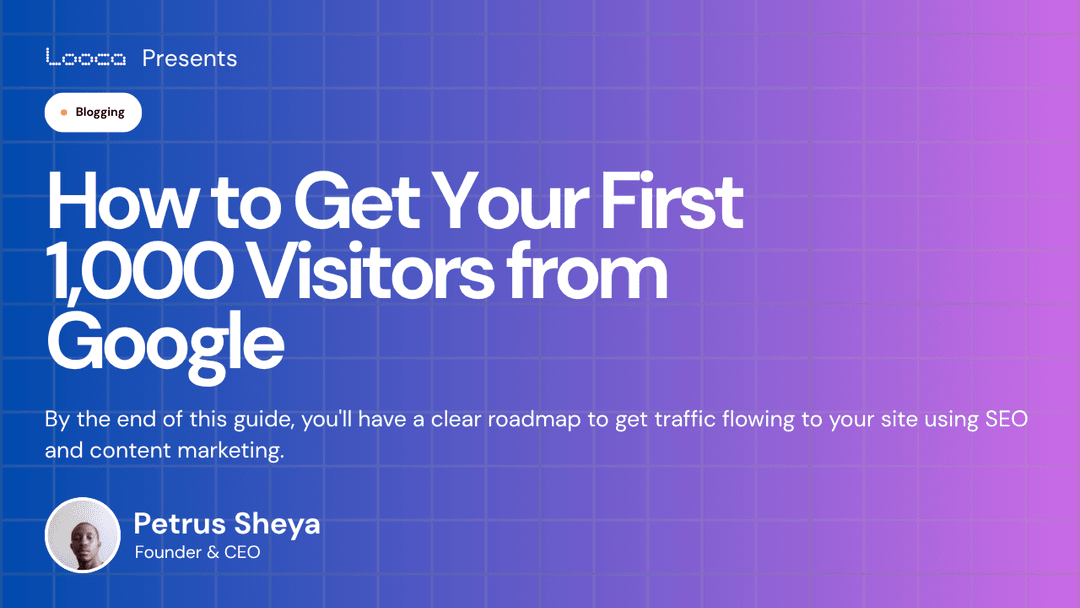How to Get Your First 1,000 Visitors from Google

Petrus Sheya
October 12, 2025

You've just launched your website, and now comes the hard part: actually getting people to find it. Maybe you're feeling a little nervous about the whole SEO thing. Maybe you've heard conflicting advice. Maybe you're wondering if anyone will ever actually visit your site.
Here's the honest truth: getting your first thousand visitors takes work, but it's absolutely doable. People are searching for what you have to offer right now. Your job is to make sure Google can find you and show you to them.
By the end of this guide, you'll have a clear roadmap to get traffic flowing to your site using SEO and content marketing. Ready? Let's go.
Step 1: Start With Keyword Research
Before you write a single word, you need to know what people are actually searching for. This is where keyword research comes in, and it's honestly the most important step you can take.
Use a keyword research tool to find keywords in your space. You're looking for two types: high-volume keywords (lots of searches) and low-volume keywords (fewer searches, but easier to rank for). The magic happens with low-volume keywords at first. These are your golden tickets.
Here's what to do: Look at the top 10 results for keywords you're considering. Are they amazing? Could you do better? If you honestly think you can create something stronger, you have a real shot at ranking. Don't aim for impossible keywords right now. Pick battles you can actually win.
Pro tip: Check page three and four of Google search results too. You'll see what weak content looks like, which helps you understand what great content should look like. This comparison is super helpful for brainstorming angles others haven't covered.
Step 2: Create Content Around Low-Competition Keywords First
This is where the magic actually happens. Pick your easiest keywords and start creating content around them. You need to build momentum, and easier keywords help you do that.
Don't pressure yourself to write perfect content on your first try. Tools can help speed up the writing process, but your voice and expertise matter most. Use writing tools to help you outline, brainstorm, and save time on first drafts. But then go in and make it real. Make it sound like you. Make it genuinely helpful.
Here's the reality: your first pieces might not be viral. That's okay. You're establishing yourself, proving to Google that you know what you're talking about, and building a foundation.
Step 3: Give Your Content a Quick Boost With Paid Promotion
When you publish something you're proud of, give it a little push with paid social media ads. Spend a modest budget to get eyes on your content in those first couple of weeks. This isn't about making it viral. It's about sending signals to Google that real people are interested in what you've written.
Think of it as introducing your content to the world. More clicks, shares, and engagement tell Google this is worth ranking higher. It's a small investment that can make a real difference in getting that first content piece traction.
Step 4: Build Topic Clusters to Show Authority
As you start ranking for some keywords, think bigger. Don't just write random posts. Create clusters of related content around broader topics.
Let's say you're in the fitness space. Instead of just writing about "running shoes," you also write about "best running shoes for flat feet," "how to prevent blisters while running," and "running shoe comparison guide." These pieces link together and tell Google you're an authority on running shoes specifically, not just fitness in general.
Over time, you'll dominate more and more keywords within that topic area. Google sees you as the go-to source. Your rankings improve. Your traffic compounds.
Step 5: Tailor Your Content for Social Media
Your blog content is great, but social media is where people actually spend their time. The key is treating each platform differently, not just copying and pasting the same post everywhere.
On Instagram, create teaser videos that highlight the pain points your blog post addresses. Use Instagram stories with stickers to drive clicks to your site. On LinkedIn, share insights and use live videos when possible. YouTube loves longer-form content that provides real value.
The goal isn't to be everywhere. It's to be strategic. Where are your people spending time? Start there and show them why your content is worth their attention.
Step 6: Capture Emails and Keep People Coming Back
Here's something many people miss: don't let visitors disappear after they read one post. Capture their email address while they're interested.
Use pop-ups or sticky bars to offer them something valuable (a checklist, template, guide, or bonus content) in exchange for their email. Then, send them more helpful content related to what brought them to your site in the first place.
This is how you turn one visitor into a regular reader. This is how you build an audience that actually cares about what you have to say.
The Honest Truth
Getting your first thousand visitors won't happen overnight. Some of these pieces might rank in a few weeks. Others might take months. That's completely normal.
But here's what makes this work: consistency. You pick keywords, create better content than what's already ranking, promote it smartly, and build a body of work that shows Google you're serious. You repeat that process again and again.
And one day, you'll look at your analytics and realize you've hit a thousand visitors. Then two thousand. Then more.
You've got this. Now go create something great.
